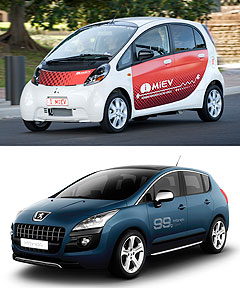Plug-in Pug pops up ahead of Frankfurt
BY RON HAMMERTON | 9th Sep 2009

Just a week after Peugeot parent company PSA inked an agreement with Mitsubishi Motors Corporation (MMC) to share its EV for Europe-only sales, Peugeot today released a picture of the Peugeot iOn ahead of its first public appearance at the Frankfurt motor show next week.
As the picture reveals, the Peugeot iOn is lightly tweaked re-badged version of the Mitsubishi i-MiEV, which is expected to be sold in Australia in small numbers to select corporate “ambassadors” from early next year.
The sheetmetal appears to be near identical, with changes restricted to plastic panels such as the front fascia, and trim items such as the wheels and additional foglightsThe Peugeot and Citroen variants are unlikely to enter the Australian market, as the deal with PSA is restricted to European sales where they reportedly hope to sell up to 25,000 i-MiEV-based EVs a year.

There is no word yet on the Citroen version, but with the Peugeot iOn out and about, the Citroen EV can’t be far behind and may yet turn up at Frankfurt with several other new Citroen models and concepts.
Peugeot describes the iOn as the spiritual successor to its Peugeot 106 Electric, which it sold in Europe between 1993 and 2003. While numbers were small, Peugeot claims the 106E made Peugeot the biggest electric car-maker in the world.
Like the plug-in i-MiEV, the Peugeot iOn will run only on electricity, with a range of up to 130km per charge from its lithium-ion batteries and a top speed of 130km/h.
The batteries can be recharged in six hours using a conventional mains power supply or recharged to 80 per cent capacity within 30 minutes using a fast-charging system.
Peugeot says its iOn will get a “localised communication unit” which controls a number of electronic functions such as an automatic emergency services alert in the event of a serious crash – similar to GM’s OnStar system – and travel data transfer for fleet operators.
The ‘zero-emissions’ iOn will be joined in the Peugeot range a few months later by the diesel-electric 3008 Hybrid4 five-door hatch, in the first half of 2011, and possibly a similarly powered RCZ coupe.
PSA’s HYbrid4 system – also to be shared with Citroen and co-developed with Robert Bosch GmbH – uses a conventional 2.0-litre turbo-diesel engine that drives the front wheels through a six-speed manual gearbox, with electric propulsion via an electric motor at the rear axle powering the back wheels.
Peugeot says the combined power of the petrol-electric drivetrain is 147kW, and cuts CO2 emissions to just 99g/km).
Citroen’s DS5 will also be launched with HYbrid4 in 2011.
Production of the Peugeot iOn is due to start in October 2010, with a commercial launch before the end of 2010.
MMC launched the i-MiEV in its domestic market in June and will begin global sales of right-hand drive versions in the final quarter, with Australia among the first recipients outside Japan. MMC will expand its international rollout to left-hook markets in its fiscal year 2010.
MMC and PSA have other joint-venture programs in place, such as the Mitsubishi Outlander-based Peugeot 4007 and Citroen C-Crosser. The companies also plan to jointly manufacture cars in Russia.